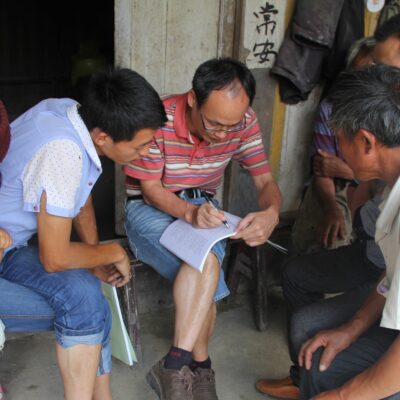In early 2020, President Xi Jinping announced China’s ambition to respond to the 2021 United Nations Climate Change Conference (COP26) climate change aims. China aims to peak carbon emissions by 2030 and achieve carbon neutrality by 2060 (known as the 30/60 goal). As the world’s largest carbon emitter and the second-largest economy, such a decarbonisation target will profoundly affect whether the world can limit the temperature increase to 1.5 °C above pre-industrial levels.
However, when Xi’s announcement was made, no one could precisely anticipate how deeply COVID-19 would impact the economy. At first, many policymakers supposed it would only create short-term economic turbulence for China, such as the SARS outbreak in 2003. But over the past two years we have seen that COVID-19 has severely shocked the entire world economy, including China. China’s GDP growth rate declined to 4.8 percent in the first quarter of 2022, lower than the whole-year growth target of 5.5 percent. The July 2022 unemployment rate for those aged 16-24 rose to 19.9 percent and triggered concerns about the further economic slowdown.
China believes it can still reach its ‘3060 goal’
The challenge is great. China’s annual total energy consumption per annum is approximately 4.9 billion tonnes of coal equivalent (tce) and the nation emits around 10 billion tonnes of CO2 . Coal accounts for approximately 56 percent of total energy consumption, while non-carbon energy sources account for only15.3 percent of total energy consumption. China’s industrial sector currently accounts for approximately 68 percent of its total carbon emissions. It is a unique feature of being the ‘world’s factory’ that China’s sectoral distribution of carbon emissions is quite different from other developed countries.
China’s transition away from carbon energy can lead to sustainable economic growth in the long run, but in the short term more carbon emission restrictions and environmental regulations in the industrial sector may further push the economy into turmoil. If economic recovery policies take priority, regulators may loosen their focus on emissions reduction in the industrial sector. This may mean that China’s emissions rise more than previously predicted before reaching the carbon peak in 2030, thereby increasing the difficulty of achieving the carbon neutrality target of 2060.
China’s stated resolution of achieving the ‘3060 goal’ is unwavering at the top policy decision-making body level, despite facing many uncertainties in the economy and fluctuations in the industrial sector. However, it seems that there have been some shifts in policy focus after COVID-19. These shifts are present in recent national leaders’ speeches and the 14th Five-Year Plan starting from 2021.
China’s (post)-COVID energy transition away from carbon will not be like Western nations
Over recent decades, China’s energy sector has seen a substantial increase in fossil fuel consumption accompanied by a striking development of renewable energy. For instance, from 1990 to 2019, China’s coal consumption increased from 1.06 billion tonnes to 4.02 billion tonnes, quadrupling in 30 years. Accompanying this, total renewable electricity production increased from 615,005 GWh in 2008 to 2,322,700 GWh in 2021, nearly quadrupling in only 13 years. The increasing rate of renewable energy is much faster than that of fossil fuels, It means China’s energy transition is occurring at the margin as the fossil fuels are incrementally being displaced by renewables. This differs from Western countries, many of which have decreased their fossil fuel consumption as they increase their consumption of energy from renewables.
China’s conditions are also distinctive. China lacks oil and natural gas reserves, but coal endowments are rich and its current energy supply is heavily reliant on coal. In 2019, coal made up 57.7 percent of total energy consumption and thermal power takes 68.88 percent of electricity generation. This situation means that China will not be able to adopt a coal displacement policy at this stage.
Further, the Ukraine war has led to an increase in coal, oil and gas prices, which has raised huge concern about an impending energy crisis. This means that Chinese energy policymakers have become more focused on energy security than before, which may make the transition to renewable energy more difficult.
The Chinese leaders understand that China’s energy transition needs to be more pragmatic and progressive than ever. The ‘3060 goal’ is still China’s pursuit. but China hopes to take its own rhythm and avoid aggressive changes. It will be based on its own situation, and focus on solving problems of the economy such as air pollution, energy affordability, energy security, energy supply chain stability, and the technological transformation of the traditional energy sector. Xi Jinping has emphasised that a new energy system must be established first before phasing out conventional energy: ‘[y]ou can’t throw away the bowl in your hand before you get a new one’. China will insist on making progress while maintaining stability.
The transformation of the coal sector will be highlighted
In its 14th Five-Year Plan, China highlights the development of the what it calls the ‘clean and efficient utilisation of coal’. This aims to maximise the efficiency of coal and minimise emissions while ensuring national energy supply, as Xi Jinping points out ‘reducing carbon is not reducing productivity’. China produced 4.13 billion tons of coal in 2021, which is impossible to replace in a short period. So, China’s ‘3060 goal’ should be based on reality and seek a profound transformation of coal utilisation. Even after the carbon peak in 2030, coal-based electricity will still play an essential role in China.
Han Zheng, the Deputy Prime Minister in charge of the energy sector, has stated that the cleaner and more efficient use of coal is crucial to achieving the carbon peak goal and carbon neutrality. He also stated that governments should promote green and low-carbon energy sources gradually and in a scientific way to provide a more solid foundation to realise high-quality development and energy security.
China’s ‘3060 goal’ goes beyond energy and carbon content
In official documents, China hopes the ‘3060 goal’ can be a ‘steering wheel’ for policy makers to navigate the direction of the whole nation’s development. Further to realising carbon peak and carbon neutrality, China aims to be a world leader in renewable energies such as solar and wind by developing new technology for batteries and energy storage, big data, and artificial intelligence in the energy system. Therefore, from the central to local governments, promoting technological progress and innovation are at the centre of carbon policy design.
Chinese leadership has highlighted that energy storage technology is the foundation for a low-carbon power system. According to the 14th Five-Year Plan New Energy Storage Development Implementation Plan, China will develop a business model for ‘renewable energy plus storage’ by 2025. By 2030, it’s envisaged that the national energy storage market will be fully developed and many advanced technologies will be marketised.
To realise these plans, the National Energy Administration is preparing to approve 219 pumped-hydro storage projects with a total investment of around 1.6 trillion Yuan. Further, the 14th Five-Year Plan focuses on the construction of pilot projects for energy storage technologies such as flow batteries, flywheels, and innovations in compressed air technologies. Specifically in relation to batteries, the Plan will support research and development projects focusing on a new generation of high-energy-density energy storage technologies, including sodium-ion and solid-state lithium batteries; and the application of hydrogen and ammonia storage technologies will be expanded. In the coal sector, projects will be developed in relation to the extraction of steam storage for thermal power.
In summary, the COVID-19 pandemic has brought about many profound impacts on the Chinese economy and the ‘3060 goal’. Despite concerns about future energy security, China’s leadership remains committed to its ‘3060 goal’ as it seeks to lead the world in new technologies relating to both conventional and renewable energy.
Dr Dong Wang: Crawford School of Public Policy, Australian National University and Centre for Contemporary Chinese Studies, The University of Melbourne.
Image: Tianjin Integrated Gasification Combined Cycle Power Plant Project, China. Credit: Asian Development Bank/Flickr




